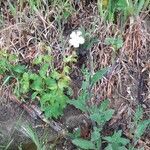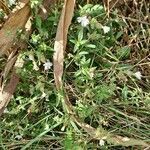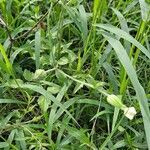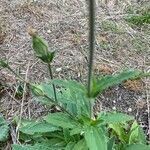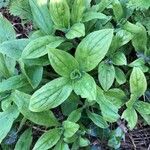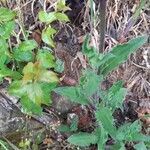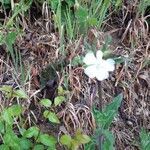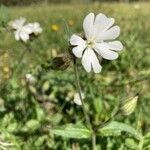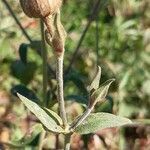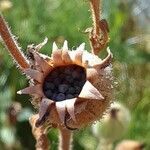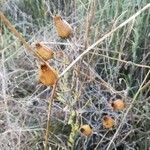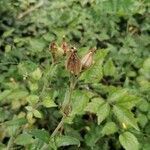Herbs annual or biennial, rarely perennial, dioecious, 40--80 cm tall. Stems erect, branched, basally villous, apically glandular villous. Proximal cauline leaves elliptic, base attenuate into short petiole; distal leaves sessile, orbicular-lanceolate or lanceolate, 6--8 × 1--2.7 cm, densely pubescent, 3-veined, apex acuminate. Flowers unisexual, forming dichasial cymes. Pedicel usually less than 1 cm, glandular villous; bracts ovate-lanceolate, villous. Calyx pubescent, glandular hairy; calyx teeth triangular, margin glandular villous, apex acuminate; male flower calyx tubular-campanulate, 1.3--1.5 cm, longitudinally 10-veined; female flower calyx tubular-ovoid, inflated at middle in fruit, contracted at apex, 1.5--2 cm, longitudinally 20-veined. Androgynophore very short. Petals white, claws exserted beyond calyx, glabrous, cuneate, auricles inconspicuous; limbs obovate, deeply bifid; coronal scales small or inconspicuous. Stamens included. Female flower styles 5. Capsule ovoid, 1.5--1.7 cm, 10-toothed. Seeds gray-brown, reniform, 1--1.3 mm. Fl. Jun--Jul, fr. Jul--Aug. 2n = 24.
Biennial or short-lived perennial, with stout taproot. Stems unbranched or branched below, with soft eglandular hairs, becoming also glandular above, (15)-30-60-(130) cm tall. Lvs with soft eglandular hairs, green, lanceolate to ovate, acute to acuminate, petiolate, becoming sessile above; lamina (2)-4-8-(15) × (0.5)-1-2-(4) cm. Infl. a (3)-7-10-(20)-flowered dichasium, sometimes unequally branched; pedicels 1-5 cm long; bracts lanceolate, acute, green. Fls unisexual. Calyx with short to long glandular and eglandular hairs: calyx in ♂ 10-veined, cylindric, 12-18 mm long; calyx in ♀ 20-veined, ovoid, 17-25 mm long; teeth linear-acuminate, erect or recurved. Petals white; limb 2-fid, rarely 4-lobed; claw lobed at base of limb; coronal scales oblong, 2-fid, 2 mm long in ♂, 0.5 mm long in ♀. Styles 5, erect or recurved at apex, 12-20 mm long. Capsule ovoid, included or c. = calyx, 14-20 mm long; teeth 10, erect or spreading; carpophore very short. Seeds dull dark grey, triangular or reniform, flattened, warty, 1.2-1.4 mm long.
Herb, annual to perennial (biennial), usually densely and softly hairy, ± glandular above. Stems erect, much-branched, 30–80 cm high. Leaves ovate-elliptic to lanceolate, 40–90 mm long, 8–30 mm wide, with white spreading hairs, glandular above; lower leaves with petioles to 25 mm long; upper leaves sessile. Inflorescence lax, few-flowered; bracts herbaceous. Pedicels 5–45 mm long, densely hairy. Flowers unisexual, 25–30 mm diam. Calyx with flexuose hairs in male flowers 12–22 mm long, 10-veined; in female flowers 20–30 mm long, 20-veined, inflated in fruit; calyx lobes narrow-triangular, acute. Petal limb 14–18 mm long, white, deeply bifid. Styles 5. Capsule ovoid-conical, 10–20 mm long, with 10 suberect lanceolate teeth; carpophore absent. Seeds ±reniform, 1.3–1.5 mm diam., grey, bluntly tuberculate.
Dioecious annual to more often biennial or short-lived perennial from a stout root, 4–12 dm, usually hairy, becoming glandular above; cauline lvs as many as 10 pairs, lanceolate to broadly elliptic, 3–10 × 1–4 cm, acute, 3–5-nerved, the lower petiolate; infl usually much branched; fls white, odorous, opening in the evening; cal in male fls 1.5–2 cm, 10-nerved, in female 2–3 cm, 20-nerved and becoming much inflated; pet 2–4 cm, the claw exsert, auriculate, the appendages 1–1.5 mm, erose, the blade deeply bilobed; styles mostly 5; fr 10–15 mm, dehiscent by 10 erect or spreading teeth; seeds gray, with blunt tubercles; 2n=24. Native of Europe, established as a common weed throughout much of N. Amer. May–Sept. (S. pratensis; S. alba, a preoccupied name; Lychnis a.)
Dioecious, annual or short-lived perennial, up to c. 80 cm, ± densely soft-hairy and glandular in upper part. Leaves ovate-narrowly elliptic or ovate, cauline leaves sessile. Inflorescence few-flowered. Flowers large, opening in the evening, faintly scented. Calyx of male flowers 15-20 mm, 10-veined, of female flowers 20-30 mm, 20-veined, inflated in fruit, glandular, calyx teeth long, acuminate. Petals usually white. Ovary ovoid; styles 5. Capsule ovoid, 10-20 mm, dehiscing with 10 erect teeth. Seeds with plane faces and obtuse tubercles.
A herb. It grows each year from seed. It grwos 40-80 cm tall. The leaves are sword shaped and 6-8 cm long by 1-3 cm wide. They are hairy.
